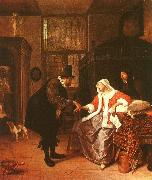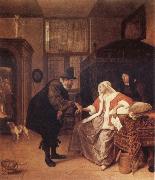Wholesale Oil Painting No Minimum |
|||||||||||
|
|
|||||||||||

|
|||||||||||
|
|
|
||||||||
Jan SteenDutch Baroque Era Painter, ca.1625-1679 Daily life was Jan Steen's main pictorial theme. Many of the genre scenes he portrayed are lively to the point of chaos and lustfulness, even so much that a Jan Steen household, meaning a messy scene, became a Dutch proverb (een huishouden van Jan Steen). Subtle hints in his paintings seem to suggest that Steen meant to warn the viewer rather than invite him to copy this behaviour. Many of Steen's paintings bear references to old Dutch proverbs or literature. He often used members of his family as models. Jan Steen painted also quite a few self-portraits, in which he showed no tendency of vanity. Steen did not shy from other themes: he painted historical, mythological and religious scenes, portraits, still lifes and natural scenes. His portraits of children are famous. He is also well known for his mastery of light and attention to detail, most notably in textiles. Steen was prolific, producing about 800 paintings, of which roughly 350 survive. Steen's work was valued much by contemporaries and as a result he was reasonably well paid for his work. He did not have any students, but his work proved a source of inspiration for many painters. |
||||||||
|
|
||||||||
The Lovesick Woman
The Lovesick Woman Painting ID:: 3743 |
1660
Alte Pinakothek, Munich 1660 Alte Pinakothek, Munich |
|||||||
|
|
||||||||
Jan SteenDutch Baroque Era Painter, ca.1625-1679 Daily life was Jan Steen's main pictorial theme. Many of the genre scenes he portrayed are lively to the point of chaos and lustfulness, even so much that a Jan Steen household, meaning a messy scene, became a Dutch proverb (een huishouden van Jan Steen). Subtle hints in his paintings seem to suggest that Steen meant to warn the viewer rather than invite him to copy this behaviour. Many of Steen's paintings bear references to old Dutch proverbs or literature. He often used members of his family as models. Jan Steen painted also quite a few self-portraits, in which he showed no tendency of vanity. Steen did not shy from other themes: he painted historical, mythological and religious scenes, portraits, still lifes and natural scenes. His portraits of children are famous. He is also well known for his mastery of light and attention to detail, most notably in textiles. Steen was prolific, producing about 800 paintings, of which roughly 350 survive. Steen's work was valued much by contemporaries and as a result he was reasonably well paid for his work. He did not have any students, but his work proved a source of inspiration for many painters. |
||||||||
|
|
||||||||
|
|
The Lovesick Woman
The Lovesick Woman Painting ID:: 33726 |
mk86
c.1660
Munich,Bayerische Staatsgemalde-sammlungen,Alte Pinakothek
mk86 c.1660 Munich,Bayerische Staatsgemalde-sammlungen,Alte Pinakothek |
||||||
|
|
||||||||
|
Jan Steen Dutch Baroque Era Painter, ca.1625-1679 Daily life was Jan Steen's main pictorial theme. Many of the genre scenes he portrayed are lively to the point of chaos and lustfulness, even so much that a Jan Steen household, meaning a messy scene, became a Dutch proverb (een huishouden van Jan Steen). Subtle hints in his paintings seem to suggest that Steen meant to warn the viewer rather than invite him to copy this behaviour. Many of Steen's paintings bear references to old Dutch proverbs or literature. He often used members of his family as models. Jan Steen painted also quite a few self-portraits, in which he showed no tendency of vanity. Steen did not shy from other themes: he painted historical, mythological and religious scenes, portraits, still lifes and natural scenes. His portraits of children are famous. He is also well known for his mastery of light and attention to detail, most notably in textiles. Steen was prolific, producing about 800 paintings, of which roughly 350 survive. Steen's work was valued much by contemporaries and as a result he was reasonably well paid for his work. He did not have any students, but his work proved a source of inspiration for many painters. The Lovesick Woman mk86 c.1660 Munich,Bayerische Staatsgemalde-sammlungen,Alte Pinakothek |
||||||||
|
|
||||||||
|
Prev Next
|
||||||||
|
|
||||||||
|
Related Paintings to Jan Steen :. |
||||||||
|
|
||||||||
|
CONTACT US |


